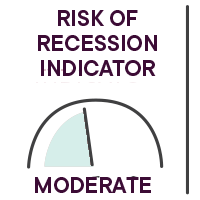Yann Furic
B.B.A., M. Sc., CFA®
Senior Portfolio Manager, Asset Allocation and Alternative Strategies
What moved the markets:
No change in the Bank of Canada’s policy rate or the Fed’s.
Canadian economy slowing.
U.S. economy stable.

|
OVERVIEW OF GLOBAL EQUITY MARKETS |
||||
|
Country |
Index |
Return |
Change |
Return for the year 2023 |
|
Canada |
S&P/TSX |
3.91% |
|
11.75% |
|
United States |
S&P 500 |
1.67% |
|
22.90% |
|
|
Nasdaq |
2.68% |
|
40.76% |
|
International stock markets |
EAFE |
2.42% |
|
15.07% |
|
Emerging markets |
|
1.05% |
|
6.88% |
|
China |
MSCI China |
-5.09% |
|
-13.58% |
* All percentages are in Canadian dollars. Source: Morningstar Direct.
Results – Canadian bonds
The FTSE Canada Universe Bond Index posted a positive return of 6.69% for the year 2023.
Source : Morningstar Direct.
Our analysis of events

Sharp rise in the financial markets in the final months of 2023
With inflation continuing to fall during the last quarter, the Canadian and U.S. central banks slowed their rate hikes, but are also considering rate cuts in 2024. However, the war is not won, as the heads of these institutions like to point out. The markets will therefore continue to react to inflation, but we could expect rate cuts as early as the end of the first quarter of 2024.
Economic data seem to be pointing to a slowdown as the rate hikes work their way through the economy, reducing consumption of non-essential goods and services. The announcements of restaurant closures in recent weeks are a case in point.
Since inflation seems to be turning the corner, central banks should start cutting rates. The markets are already anticipating several cuts, between five and six in Canada and the U.S., which would bring the policy rates down to 3.75% in both countries by late 2024.
Possible scenarios in 2024
- The most positive scenario would be a rate cut due solely to a decline in inflation, with no pronounced economic slowdown.
- Alternatively, rates could be cut to revive an economy facing a severe recession.
- Finally, we could see re-accelerating inflation while the economic situation deteriorates. This would indicate a state of stagflation, which would be the most negative scenario.
In the Canadian context, we know that mortgage terms are generally five years. The renewal of mortgages issued in 2020 and 2021 will force the homeowners concerned to make higher mortgage payments starting in 2025 and 2026. However, wage increases since 2020 should help reduce the impact of these higher payments, and mortgage rates should still be lower than in 2023. The current labour shortage should also help limit job losses, thereby bolstering the economy.
Lower rates are also good news for small and medium-sized businesses, as they should find it easier to obtain the financing they need and thus participate in the economic recovery.
Employment situation
In December 2023, Canada’s unemployment rate came in at 5.8%, the same as the previous month and in line with market expectations. This is the highest rate recorded since January 2022, with the number of unemployed reaching 1.24 million. Some 1,000 jobs were added, well below the market consensus of 15,000. Wage inflation remained high, at 5% for the past 12 months.
In the United States, job creation data for December exceeded expectations, with 199,000 jobs added versus forecasts of 185,000. The unemployment rate remained stable at 3.7%, while wage inflation rose from 4% to 4.1% year-on-year.
Economic indicators
Global Purchasing Managers’ Index ![]()
Once again in December, the indices show a marked difference between the manufacturing economy, which is slowing, and the services component, which continues to grow, but at a slower pace.
Inflation rate ![]()
The inflation rate is still too high, but certain indicators are moving in the right direction. Wage inflation in Canada is still too strong.
Benchmark rates in Canada, Europe and the United States ![]()
If interest rates remain at current levels for an extended period, this will have a major impact on household and business spending when loans are renewed. This situation will further dampen household consumption and investment.

Our strategic monitoring
We maintained a cautious positioning throughout 2023. We participated in the market rise, but with lower exposure to U.S. large-cap technology stocks.
We are monitoring inflation and keeping a particularly close eye on leading indicators for manufacturing production, the services sector and employment. A deterioration in these numbers would prompt us to be even more cautious.
A notable improvement in the manufacturing indices and a return to an inflation rate of 2% would be strong signs of an economic recovery, but above all of a possible soft landing for the economy.
Caution and risk management remain our priorities.
Our tactical positioning
In December, we increased the weighting of equities relative to bonds.
We also invested in small-cap stocks, which react well to rate cuts. We maintained our overweight position in Japan relative to Europe, since the Japanese economic outlook seems to be brighter.
In the United States, we maintained our position in large-cap growth stocks, which react positively to stabilizing interest rates, as well as in stocks with a track record of dividend growth which are more defensive. We also initiated a position in small-cap stocks.
We continue to favour stocks in developed countries.
Since the Bank of Canada’s policy rate increase in early June, we have taken a position in 10-year Canadian bonds, since we believe that longer-term yields will peak over the next few months and then stabilize or decline. We increased this weighting in July, August, October and November.
To learn how our funds performed:
View the returns
Main risks
- An overly restrictive monetary policy could cause a major recession or other problems, like the U.S. regional bank crisis.
- High interest rates for an extended period would reduce corporate profits and sharply curtail household spending.
- The possibility of an episode of stagflation, i.e. anemic economic growth and high inflation, persists. This situation is negative for stock markets.
- The Israeli-Palestinian conflict could escalate and spread throughout the Middle East.
- The conflict in Ukraine could spread to other European countries.
- There is also a risk that tensions could worsen between China and the United States over Taiwan.
Senior Manager, Asset Allocation and Alternative Strategies
Data source : Bloomberg
The opinions expressed here and on the next page do not necessarily represent the views of Professionals’ Financial. The information contained herein has been obtained from sources deemed reliable, but we do not guarantee the accuracy of this information, and it may be incomplete. The opinions expressed are based upon our analysis and interpretation of this information and are not to be construed as a recommendation. Please consult your Wealth Management Advisor.




















